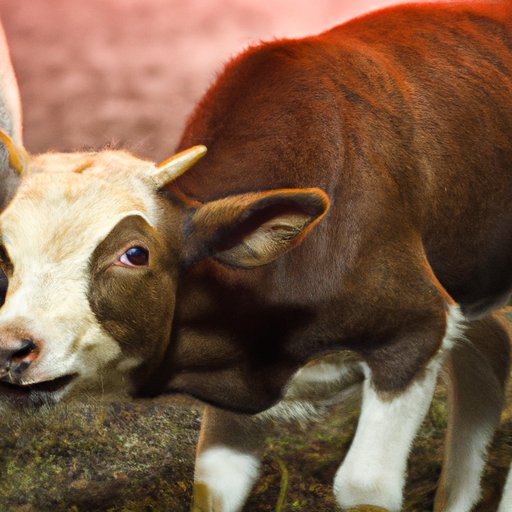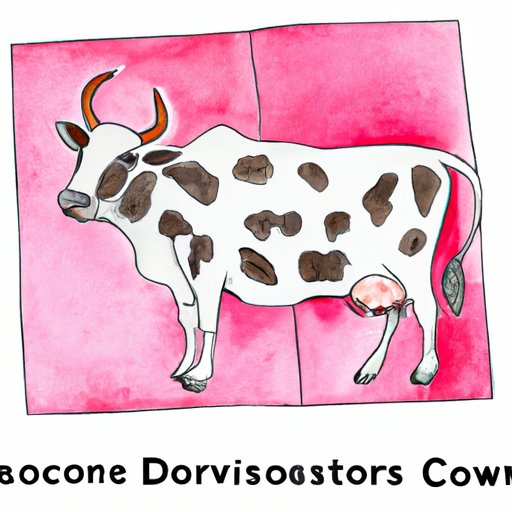
Introduction
Mad cow disease, also known as bovine spongiform encephalopathy (BSE), is a fatal neurodegenerative disease that affects cattle. The disease is caused by an abnormal protein called a prion, which damages and kills nerve cells in the brain and spinal cord. In rare cases, people who eat contaminated beef products can develop a related disease called variant Creutzfeldt-Jakob disease.
In this article, we will explore the scientific origins of mad cow disease, the link between the disease and government regulation, the global health implications of outbreaks, the psychological impact of mass panic, the socioeconomic impact on the food industry, and the efforts being made to prevent future outbreaks of the disease.

Exploring the Scientific Origins of Mad Cow Disease
To understand mad cow disease, we must first understand prions. Prions are misfolded proteins that can replicate themselves by causing normal proteins to become misfolded. When prions build up in the brain, they cause neurodegenerative diseases such as mad cow disease, Creutzfeldt-Jakob disease, and others.
In the case of mad cow disease, prions enter the cow’s nervous system through contaminated food. Once inside the cow, the prions accumulate in the spinal cord and brain, causing nerve cells to die and create holes in the brain tissue. The cow may not show any symptoms for up to five years, making it difficult to detect infected animals before they are slaughtered.
Investigating the Link Between Mad Cow Disease and Government Regulation
The outbreak of mad cow disease in the 1990s prompted governments to introduce new regulations on the beef industry to prevent the spread of the disease. These regulations included testing of all slaughtered cows, bans on feeding cows with meat and bone meal, and controls on the export of beef from infected countries.
However, in recent years, some governments have relaxed these regulations to promote economic growth. This has led to concerns that the disease may be spreading once again, potentially putting public health at risk.
Discussing the Global Health Implications of Mad Cow Disease
The global nature of the beef industry means that outbreaks of mad cow disease can have far-reaching implications beyond the countries where the disease originated. In the 2000s, there were several outbreaks of mad cow disease in other countries, including Canada, the United States, and Japan.
These outbreaks led to a decline in consumer confidence in beef products and disrupted international trade in beef. In some cases, countries banned the import of beef from infected countries, leading to economic losses for farmers and beef producers.
Analyzing the Psychological Impact of Mad Cow Disease
When mad cow disease outbreaks occur, they often receive extensive media coverage, leading to mass panic among consumers. This panic can lead to a decline in beef consumption and economic losses for the food industry.
Public health officials must balance the need to inform the public about disease outbreaks with the need to prevent panic. This can be achieved through clear, transparent communication and effective risk management strategies.
Exploring the Socioeconomic Impact of Mad Cow Disease
The economic impact of mad cow disease extends beyond the food industry. Farmers and beef producers may suffer financial losses due to disease outbreaks, and workers in related industries may lose their jobs. The ripple effects of outbreaks can spread throughout the entire economy, leading to reduced consumer spending and a decline in economic growth.
Preventing disease outbreaks through effective regulation and safety measures is crucial to maintaining the stability of the food industry and the wider economy.
Examining how Scientists and Farmers are working to Prevent Future Outbreaks of Mad Cow Disease
To prevent future outbreaks of mad cow disease, scientists and farmers are working on innovative research and practices that reduce the risk of disease transmission. For example, some farmers are using synthetic amino acids instead of meat and bone meal to feed cows, while others are using genetic selection to breed cows that are less susceptible to the disease.
In addition, proper food safety protocols, such as thoroughly cleaning slaughterhouses and using separate equipment for different animals, can reduce the risk of contamination. The role of government in regulating the industry and ensuring food safety cannot be overstated.
Conclusion
Mad cow disease remains a serious concern for the food industry and public health officials worldwide. Understanding the science behind the disease, the link between government regulation and outbreaks, the global health implications, the psychological impact, and the socioeconomic impact provides valuable insights into the importance of preventing future outbreaks.
Efforts by scientists, farmers, and governments to reduce the risk of disease transmission through innovative research, proper food safety protocols, and effective regulation are crucial to maintaining the stability of the food industry and the wider economy.
The audience must be aware of the risks of a disease outbreak and the need for preventive measures.




